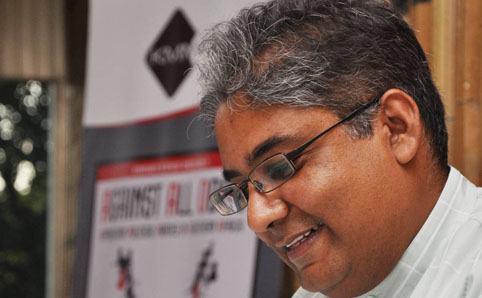 |
|
Prof. Hussein Solomon
Photo: Stephen Collett
|
“We are good in opposing people, but we’re less good in opposing ideas.” This was how Prof. Jonathan Jansen, Vice-Chancellor and Rector of the University of the Free State (UFS) introduced the book launch of Against all Odds: Opposition Politics in Southern Africa.
The event was hosted in collaboration with the publisher under the title: Are opposition parties in South Africa in a crisis? This formed part of a series of dialogue sessions, organised by the Centre for Africa Studies, in the run up to the local elections.
Amongst those interested who attended the evening in the Senate Hall of the CR Swart Building on the Main Campus were various politicians, students, staff en a panel consisting of academics and the respective provincial representatives of the ANC and DA.
Dr Mcebisi Ndletyana from the Human Sciences Research Council (HSRC), acted as arbiter.
Proff. Hussein Solomon, author of Against all Odds: Opposition Politics in Southern Africa, also lecturer at the UFS, as well as Dirk Kotzé, Head of the Department of Political Science at Unisa, delivered enriching lectures on the stance and positioning of opposition parties.
Prof. Hussein, who spoke first, circumscribed the context of the political climate in the country, based on his book. “The problem that political science encounters is that everybody becomes experts on the internet, while they have no experience of what is happening in South Africa.” He said that when political parties in the country are under discussion, voters often allow myths and/or stereotyping to influence their concept of it. ‘’If there are no opposition parties, there is no democracy and people are deprived of their vote.”
Prof. Kotzé stated in his speech that it was not only opposition parties who had to make the government watch its step, but also the status that the country acquired, amongst others, from its connections, i.e. collaborative agreements such as BRICSA and the country’s inclusion in the G20. He left the audience with a question about how they were going to become involved in politics, and with his rhetoric question referred to options like social networks and movements.
Mr Sibongile Besani, the ANC'S secretary in the Free State, said the DA grew due to it’s swallowing of other parties; something he claims is taking the country backwards. He also described the use of personalities by opposition parties as means of association a weakness. He added that voters will continue voting for the ANC because they can associate themselves with the party’s vision.
In contrast, Mr Roy Jankielsohn, provincial leader of the DA, said voters and parties unite under their core vision for the country as like in the case of the ANC during the liberation struggles.
During the question-and-answer session, which followed after Mr Jankielson’s speech, Prof. Kwandiwe Kondlo, upon completion and summary of the discussions, stated firmly that the opposition parties are in a crisis. “The start of the solution is to recognise the problem. That is why our democracy finds itself in the state in which it is; because the opposition does not fulfil the role that they are supposed to fulfil.“ Prof. Kondlo is the head of the Centre of Africa Studies at the UFS.
He concluded by stating that the economic basis in the country was not transformed. “We cannot say that people determine their futures if they posses nothing. Opposition parties must start to communicate at this level in order to table something new. Our democracy must become more inclusive at political and material level.”